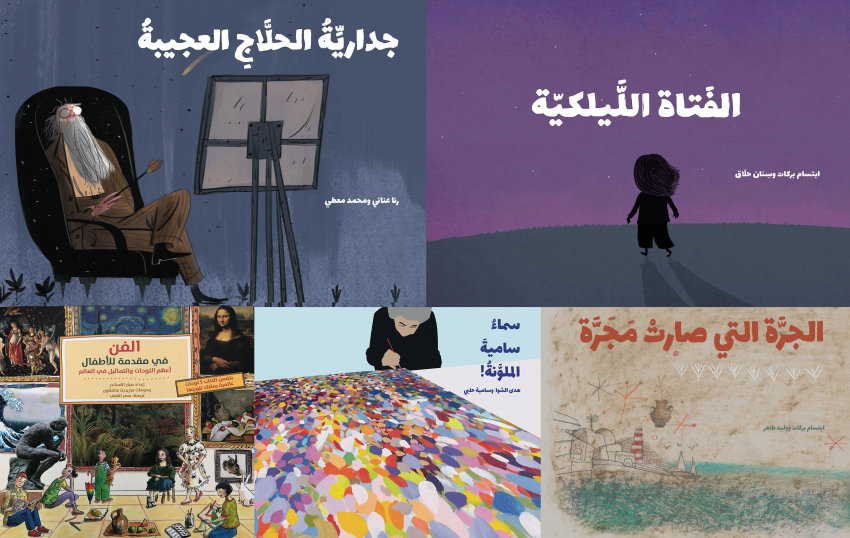
The Tamer Institute for Community Education has concluded the “Tales from Palestinian Art” Project with the publication of four illustrated stories based on the lives of a group of pioneering Palestinian visual artists. The project has also published an Arabic version of a book entitled ‘The World’s Greatest Paintings and Sculptures’ by Heather Alexander, with illustrations by Meredith Hamilton, that introduces children to the art world.
The project is funded by the “Visual Arts: A Flourishing Field” (VAFF) Project, managed by the A.M. Qattan Foundation’s Culture and Arts Programme (CAP).
The stories include ‘Samia’s Colourful Sky’, inspired by the life of artist Samia Halaby and written by Huda al-Shawwa and illustrated/designed by Samia Halaby herself; ‘The Urn that Turned Into a Galaxy’, inspired by the life of artist Vera Tamari and written by Ibtisam Barakat and illustrated by Walid Taher; ‘The Purple Girl’, inspired by the life of artist Tamam al-Akhal and written by Ibtisam Barakat and illustrated by Sinan al-Hallaq; and ‘The Fantastical Mural of al-Hallaj’ inspired by the life of the artist Mustafa al-Hallaj and written by Rana Anani and illustrated by Mohammad Mo’ti.
The stories are designed for children between the ages of six and twelve years old. Samia Halabi’s story targets twelve-year-old and older children in particular. The project has also produced online guides featuring interactive activities that present and make visual arts techniques more accessible for children and their families.
The translation of ‘The World’s Greatest Paintings and Sculptures’ book aims to make educational material on the history of art available in Arabic, and also includes reproductions of five masterpiece paintings for the reader to colour in. It was translated into Arabic by Samar al-Qotob under the title ‘A Child’s Introduction to Art – The World’s Greatest Paintings and Sculptures’.
The publications are available at the Leila Miqdadi al-Qattan Library at the AMQF’s headquarters in Ramallah’s Al Tireh neighbourhood, at the Yabous Cultural Centre in Jerusalem, the Tamer Institute for Community Education in Ramallah and Gaza, the Arab Cultural Association in Haifa and the Palestinian Museum in Birzeit. They will also be available soon at the Al Halabi Library in Lebanon and the Fattoush store in Haifa.
Commenting on this experience, artist Vera Tamari said: “This project is very important. This is the first time I witness such an experiment in Palestine, through which there is a direct interaction with artists to produce stories focusing on certain aspects of their lives with the aim of introducing them to children. Because of how art education in our schools stipulates a sort of restraint on how children can express themselves, this could be the first time that children hear our names as artists, while the existence of these stories, and the accompanying activities, introduce children to the various materials artists use and their experiences in a different and appealing manner.”
Tamari also commented on the story written about her life and her artistic experience: “This story is both realistic and fictional. I collaborated with Ibtisam Barakat during the writing stage to produce a text that is interesting for children, and that reveals an aspect of my art practice, particularly the period when I was introduced to clay. When I was a child, I visited the village of Sinjel and met the women who made pottery there, which is where I discovered this material and this type of art.”
Artist Samia Halaby commented: “I was thrilled to learn about the project, and this Arab/ Palestinian effort to produce the texts and illustrations of these stories. I also appreciate the research work undertaken by Huda al-Shawwa, which showed me, during the writing stage, that she is familiar with the nature of my work.” “Huda’s idea of writing about my studio window overlooking the street also illustrates the relationship between abstraction, nature, the individual and her life, which is an important concept to convey to children through this story,” the artist added.
